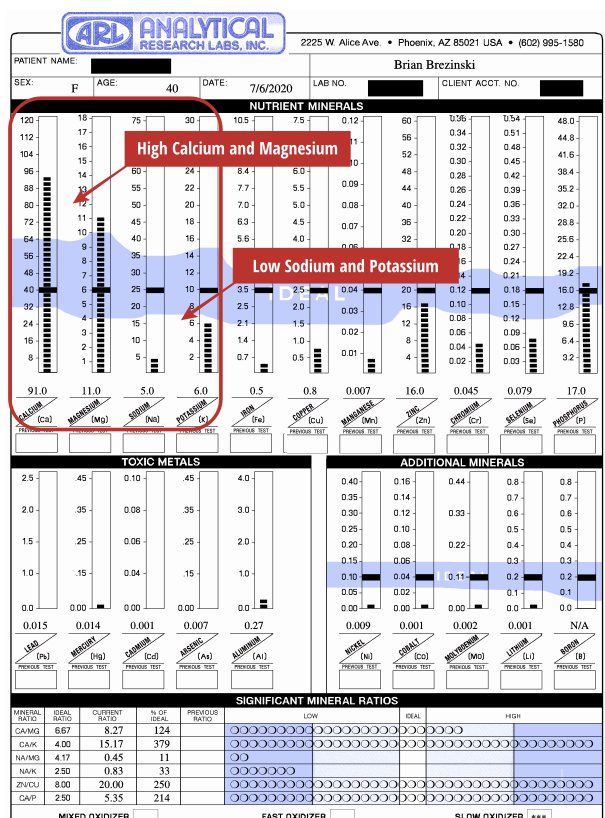How to Determine Your Metabolic Type
- Published on
- by Brian Brezinski
All information in this article is for educational purposes only. It is not for the diagnosis, treatment, prescription or cure of any disease or health condition.
Many people think that hair analysis is only useful to measure minerals and toxic metals. But the main reason I use the hair analysis test in my practice is to determine a person’s metabolic type.
What is Metabolic Typing?
Metabolic typing is a modern way to classify people based on biochemical differences. Your metabolic type tells you how your body is functioning as a system. This is the key to understanding the cause and correction of many health problems.
There are two main metabolic types: Slow Oxidizers and Fast Oxidizers.
The term oxidation is similar to metabolism and refers to the rate that your body is burning carbohydrates, proteins, and fats into energy. It has a lot to do with adrenal and thyroid gland activity.
Each metabolic type has unique characteristics and symptoms, and each requires its own set of nutrients to restore balance.
Symptoms of the Oxidation Types
Knowing your metabolic type can help you understand why you feel the way you do. Many physical and mental symptoms are due to an imbalanced oxidation rate.
The Slow Oxidizer Metabolic Type
Those with a slow oxidation rate tend to be tired, apathetic, depressed and even despairing and suicidal if their oxidation rate is very slow. Some are emotional as their copper level rises. Some are also anxious, although fatigue and depression are more common. Many use stimulant foods, drugs or other methods to keep going.
Their blood sugar and blood pressure tend to be low, at least until later in life when they can develop arteriosclerosis and diabetes, which raise these levels. They are often cold and do not sweat easily. Their brains often work slowly, and many have brain fog, spacey thinking, and slower thinking.
They usually have dry skin and dry hair, and many complain of constipation. They often gain weight on the hips and legs, while the upper body may be smaller. Most have underactive thyroid glands—especially the women. They are prone to osteoporosis, cancer, infections, skin problems, and many other health conditions.
The Fast Oxidizer Metabolic Type
Those with a fast oxidation rate tend to be anxious, irritable, in a hurry, and aggressive if their oxidation rate is very fast. They are usually somewhat emotional, short-tempered and high-strung. They easily become anxious and wound up, and may need sedative drugs to slow down.
Their blood sugar can be on the high side due to higher cortisol levels. Their blood pressure tends to be on the high side because of salt and water retention. For the same reason, their tissues often have a watery appearance (low muscle definition). They are often warm and sweat easily. Their brains often work well, with fast thinking.
They usually have oily skin, and some tendency for frequent or loose bowel movements. They may gain weight in the area of the abdomen due to high levels of cortisol and cortisone. They are in a fight-or-flight mode too much of the time. This uses up certain nutrients and eventually can result in symptoms and illnesses associated with this metabolic type. These include high blood pressure, fatal heart attacks, anxiety, panic attacks, arthritis, and others.
The descriptions of each of the metabolic types above are from The Oxidation Types—Fast, Slow and Mixed by Dr. Lawrence Wilson, December 2018
It’s important to know that being a fast oxidizer or slow oxidizer is not “bad.” One is not necessarily better than the other. However, many people become stuck in one of the metabolic types due to nutritional deficiencies, heavy metal toxicity, and other reasons.
Four Low Electrolytes—A Separate Metabolic Type
On a hair mineral analysis, a pattern called Four Low Electrolytes or “Four Lows” is considered an additional metabolic type—separate from fast or slow oxidation.
In this pattern, the four main electrolytes (calcium, magnesium, sodium, and potassium) are all below their ideal level. This is a special type of metabolic dysregulation and a deviation from the body’s normal response to go into slow or fast oxidation.
The four lows metabolic type is associated with exhaustion and a “give-up attitude.” Those with this pattern often feel “stuck” and can be cynical and negative. There is also tendency for allergies when this pattern is present.
How to Determine Your Metabolic Type
Symptoms alone can be a good guide for assessing your metabolic type. However, they are often misleading.
Some practitioners use questionnaires or other methods to determine a person’s metabolic type. But, like symptoms, these methods are less reliable. Also, some practitioners have a different idea of what the term “metabolic type” means.
Hair Tissue Mineral Analysis – A Foolproof Method for Determining One’s Metabolic Type
The best way to determine your metabolic type is to do a hair tissue mineral analysis. A properly performed and interpreted hair mineral analysis can measure your metabolic type and rate with mathematical precision. This is done by assessing the balance between calcium, magnesium, sodium, and potassium. The balance of these minerals in hair tissue is controlled largely by the adrenal and thyroid glands, which also control the body’s metabolism to a large extent.

Balancing Your Oxidation Rate Can Improve Many Symptoms At Once
Once you know your metabolic or oxidation rate, you can take steps to bring it into better balance. Thanks to the work of George Watson, PhD, and Dr. Paul Eck, many foods and nutrients have been found to influence the body’s oxidation rate.
For example, slow oxidizers need more of certain B-Complex vitamins and also vitamins C and E. They also need zinc, chromium, manganese, and other nutrients. Other vitamins and minerals are potentially detrimental for the slow oxidizer, including iron and copper, which is present in most multi-vitamin products.
By speeding up or slowing down your oxidation rate, you can improve many symptoms and health problems at the same time. Dr. Lawrence Wilson explains this phenomenon below:
“In the body, an optimum oxidation rate may provide an optimum physical and chemical environment in which millions of enzymes function best. If we can provide this, the body simply functions better with less stress. As a result, many symptoms improve easily without the need for remedies of any kind.”
Dr. Lawrence Wilson
If you are interested in doing a hair analysis to learn your metabolic type and gain additional insight into your body chemistry, click here to learn how to order a hair analysis today.
Share This Post
More Articles
-
Three Things Smart Women Avoid at All Costs: Part 1
-
Copper Toxicity from Permanent Retainer (Dental Materials): A Case Report
-
ARL vs TEI: Which is the Best Hair Analysis (HTMA) Lab Test?
-
How much does hair mineral analysis (HTMA) cost?
-
Copper IUD Warning!
-
3 Lesser-Known Stimulants that May Be Harming Your Health
-
The Dangers of Cold Plunging
-
How and When to Eat Liver
-
Basic Supplements
-
Understanding Your HTMA Test Results (Video Series)

